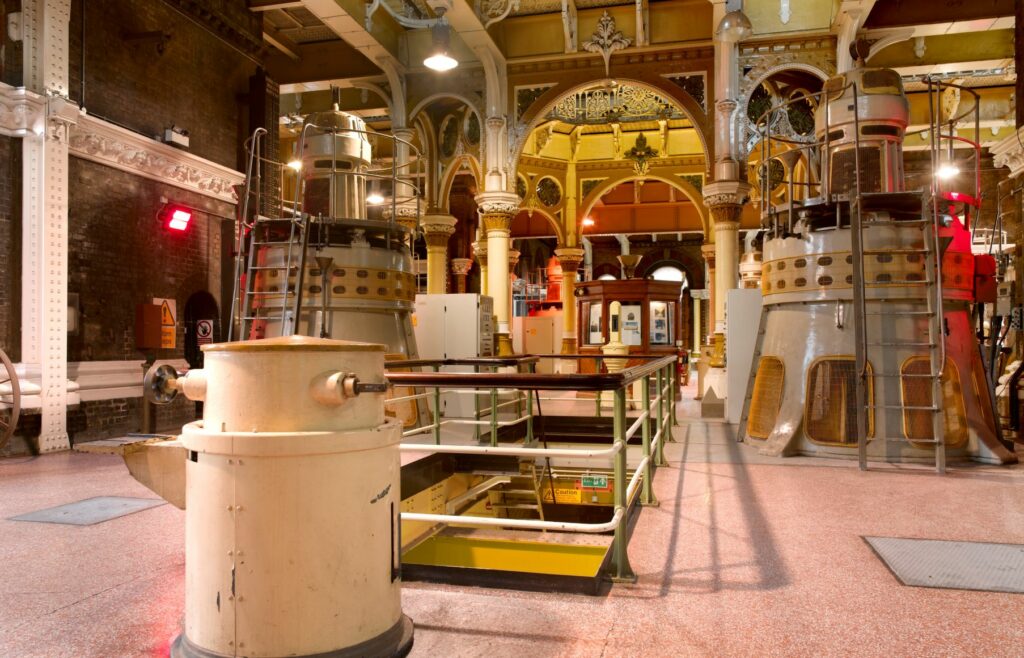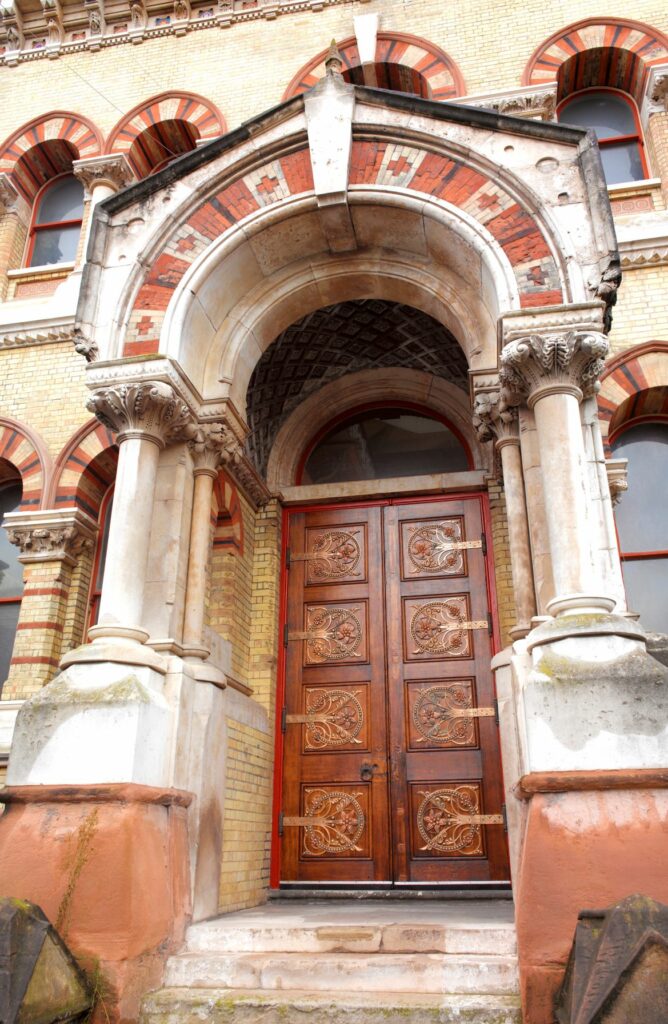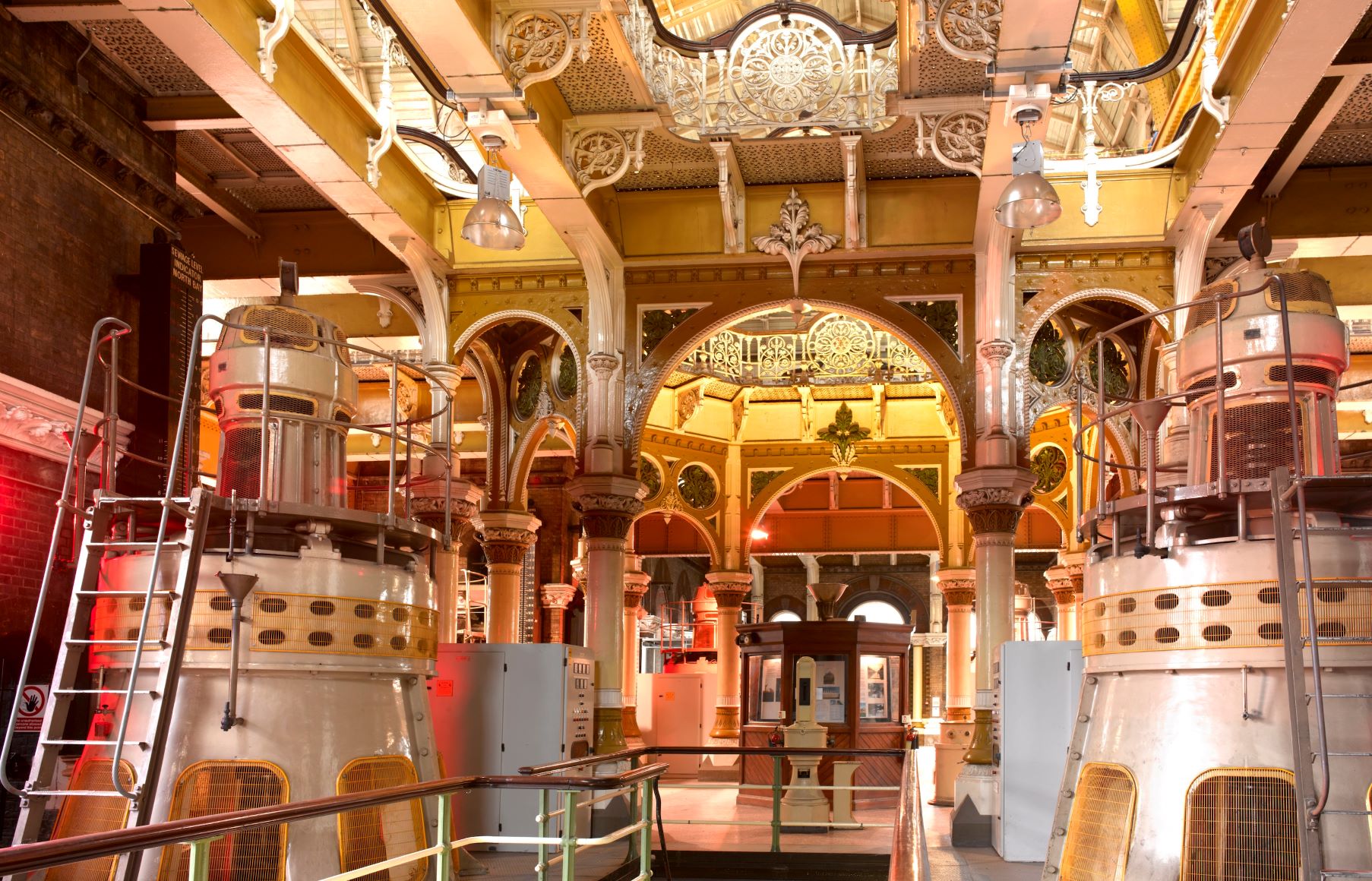A bout 12 miles east of Trafalgar Square, Crossness Pumping Station engine house is a splendid Romanesque industrial building which lies south of the Thames. Its counterpart across the river, just near Stratford, is Abbey Mills, Byzantine in appearance. They are two conspicuous features of what remains one of London’s hidden engineering secrets – its mid-Victorian sewer system.
The engine house at Crossness is a tribute to extensive restoration and preservation. The interior houses a remarkable octagonal pavilion with arched screens. Wrought iron and cast iron is used extensively for the capitals, columns, floors and spiral staircases and there is much brasswork for detail such as handrails.
At Abbey Mills the main engine house, opened in 1868, pictured above, is still in use. Its steam engines were replaced with electrical systems during the 1930s, and the electric motors and pumps remaining in the building now serve as a reserve system for Thames Water. Abbey Mills’ ironwork was designed by the same architect as at Crossness, Charles Driver. The columns and arches are now painted in more muted colours.

It’s easy to describe the building as Byzantine or Gothic but its style is hard to pin down precisely. The high dome and lantern is Russian in appearance and there were once two massive Moorish chimneys. Electrical control panels and instrumentation from a later age, now dated in appearance, does not look out of place in the Victorian engine house.
LOCAL ADVERTISING
Behind the creation of both these buildings lay the desperate need to clean up the River Thames. In the early 19th century, the fact that contaminated water was the true cause of cholera (which was to kill more than 30,000 Londoners between 1830 and 1855), was imperfectly understood. It was not until the Great Stink of 1858, when the polluted Thames generated a stench so powerful that the Houses of Parliament were rendered barely habitable, that politicians took action.
The solution, designed by chief engineer to the Metropolitan Board of Works Sir Joseph Bazalgette, was typically Victorian in its masterful approach. A network of main sewer tunnels running parallel to the Thames would be built, collecting both wastewater and surface water, and carrying it to outfalls far downriver. As the districts of London lie on different levels, the challenge was to lift much of the wastewater to a level high enough to allow it flow into the river. Three main intercepting sewers on the north side of the river at low, middle and high levels, and three on the south, would feed wastewater into outfalls at Barking and at Crossness.

Abbey Mills Pumping station was needed to raise the water from the lowest interceptor sewers to reservoirs where it could flow into the river. On the south side Crossness was able to discharge sewage directly into the river at high tide, but during low tide powerful pumping engines were needed to raise sewage water into a roofed reservoir (about the area of five football pitches) to await the change the river level.
The Southern Outfall Sewer Pumping Station at Crossness lay on the edge of what was in 1865 a bleak marsh at Erith. To the west lay Woolwich Royal Arsenal, whose firing ranges, magazines and test areas were starting to sprawl over hundreds of acres of marsh, mostly closed, dangerous and secret, a place redacted from maps.
Abbey Mills lies close to Bromley-by-Bow and was further from the outlet. On completion in 1868 it was on the outer edge of London with open country beyond. Within a year it was joined to east by the gigantic Beckton gasworks, a Hades-like collection of retorts, chimneys, gasometers, and tar beds.

Sewage from Abbey Mills flowed into the Northern Outfall Sewer which curved closely around the gas works and discharged directly into the river at Barking. Here the concentration of unpleasantness was exceptional and the outfalls at Barking and Crossness were frequently overpowering. This did briefly represent a kind of progress because sewage was being shifted out of London to the downriver outlands, but soon the grim state of the banks downriver raised another stink. A second phase of improvements was required as the realisation grew that raw sewage could not be pumped into the Thames in the expectation that the tides would take it away.
From 1887 precipitation bed systems at Barking and Crossness came into operation to extract sludge from wastewater. Sludge was loaded onto a fleet of purpose-built vessels which steamed downriver to discharge it in the deepest parts of the estuary, a system which operated for more than 100 years. The fleet of sludge carriers, numbering 16 over time, performed that duty until EC rules outlawed dumping in 1998. And as for nowadays? All sewage is processed and some of it is incinerated at Crossness and Beckton.
This is extracted from UNSEEN LONDON: Photographs by Peter Dazeley, Text by Mark Daly (Publisher: Frances Lincoln, Quarto, £32). Unseen London takes you backstage at 50 of the capital’s iconic buildings including Big Ben, Battersea Power Station, the Old Bailey and the Bank of England.
Please support us if you can
Sorry to interrupt your reading, but right now finances are especially tough here at Leytonstoner. Although we are now 7 years old and have a bigger audience and social media following than ever before, with rising Mailchimp and hosting costs, as well as advertising revenues in freefall, both Leytonstoner and our small network of independent online titles are at risk. As readers we need your support more than ever to keep delivering ‘good-news’ cultural stories that celebrate our wonderful neighbourhoods. Every reader or business contribution, however big or small, is invaluable in helping the costs of running the website and the time invested in the research and writing of the articles published. Support Leytonstoner here for less than the price of a coffee and it only takes a minute. Thank you – Stephen Emms, editor


